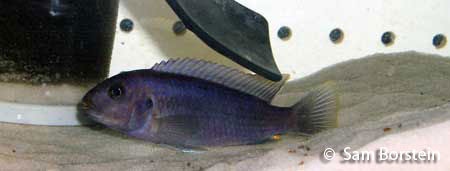Pseudotropheus perspicax
(Trewavas, 1935)
Synonyms: Melanochromis perspicax

Above: A male Pseudotropheus perspicax. Photo by Sam Borstein.
Etymology:
Genus- Pseudotropheus= False Tropheus (Latin).
Species- perspicax= with sharp eyes (Latin).
Intro:
Pseudotropheus perspicax is one of the first Pseudotropheus to be known from Lake Malawi. Even though this is an old species, finding it in the hobby can be difficult. This fish, when compared to its undescribed similar counterparts Pseudotropheus sp. "perspicax orange cap", Pseudotropheus sp. "perspicax yellow breast", and Pseudotrophueus sp. "perspicax tanzania" is a dull purple or brown fish, which causes a lack of popularity.Distribution:
Pseudotropheus perspicax is found in Lake Malawi around rocks.
Size, Maturity, and Sexual Dimorphism:
Size: Males- 4 inches, Females- 3 inchesMaturity: 2.5 inches
Sexual Dimorphism: Males are larger than females and attain a purple/blue color, while females remain brownish in color.
Care:
Pseudotropheus perspicax may be difficult to care for because it can be extremely aggressive. Males are very intolerant of other fish and even more intolerant of females that will not spawn with them. I recommend a mixed mbuna tank of 55-75 gallons to be on the safe side. Younger ones could be placed in a tank with other mbuna that is 40 gallons.
Diet:
This fish is an herbivore, feeding off of algal gardens in nature. Feed a diet with lots of vegetable matter.
Breeding:
This fish was not very hard to spawn. The problem is keeping females alive to spawn because of aggression stated above. They breed like typical Malawi fish. Fry are average size and broods are small (6-10 fry per). Females hold for about 18 days.
Conclusion:
Pseudotropheus perspicax is just another fish to keep. Due to its color it is not often seen. Don't expect to find this fish at a pet shop.
References:
- Konings, A. (2007) Malawi cichlids in their natural habitat. 4th ed., Cichlid Press, El Paso, Texas, 424 pp.
- Trewavas, E. (1935) A synopsis of the cichlid fishes of Lake Nyasa. Annals and Magazine of Natural History, 10, 65–118.
